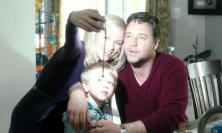Director: Mark Herman
Starring: Vera Farmiga, David Thewlis, Rupert Friend, Sheila Hancock,David Heyman
UK Release date: 12 September 2008
Certificate: 12A (94 mins)
In the first few pages of his analysis of post-Holocaust art, Efraim Sicher (in Breaking Crystal) writes of the ‘difficulties of finding a medium or text that will bear the impossibility of imagining the unimaginable’: the comforts of narrative realism, with its dependence on order, rationality and more often than not, happy endings, by necessity elides the horror that it aims to describe. The Holocaust is one of the few topics in the West that has survived the flood of irony that satirises everything it touches, and any creation that chooses it as its topic must expect to be judged through serious eyes. The Boy in the Striped Pyjamas is the story of Bruno, the son of a Nazi officer given control of a concentration camp, and his friendship with a boy on the other side of the fence: it’s an emotive story, but one that fails to stand up to the weight of its topic.
The first draft of the book on which the film is based was written by John Boyne in two and a half days. You can see how: once the initial premise has been delivered, the story writes itself. Friendship and childhood innocence break up against the father’s decisions; the family is assaulted by internal conflicts; through an 8-year-old’s eyes the irrationalities of the Nazi regime are unveiled. The tight-rope within “children’s literature” (which is what Boyne describes the novel as) is balanced over the danger of the book itself becoming childish: too simple and unbelievable. The innocence of Bruno’s mother is an example of a failure; one can’t help but wonder how, after being married for over a dozen years, she hasn’t had to face up to the ramifications of her husband’s work before. Likewise the ending of the film borders on the ridiculous, as does the children’s lack of discovery by the camp’s guards. It might not be a happy ending, but that doesn’t stop it being an unrealistic, childish ending.
Initial reactions to the film suggest that audiences are responding to its heavy emotional content. It’s well designed, despite a smothering soundtrack that doesn’t seem to trust in the images on the screen to carry the message. And it’s a relief to see a director settling on a sensible decision about accents: Mark Herman has everyone speak in British accents without adding any illogical German pronunciations. But really the characters’ story arcs aren’t anything new and the film feels portentous without having anything of particular insight or beauty to say.
This really is where the film runs into its artistic and moral problems. By focussing on the story of one boy, the risk is that the horror of the Holocaust will merely be paraphrased. I suppose the best way to deal with this risk is to have as realistic a portrayal of humanity and history as possible; The Boy in the Striped Pyjamas may have been well researched and be historically accurate, but its depiction of humanity is sacrificed to the force of its narrative. It barely escapes being melodrama, which when viewed in the light of the duty to seriousness discussed above, is a nasty little crime. And when one considers that someone somewhere is profiting from the film’s creation… Big, extraordinary emotions sell well; one of the mysteries of what happened in the concentration camps was the lack of fanfare, the lack of a soundtrack, thunder and lightening, close-ups of individuals, the way that horror was made ordinary.
The Boy in the Striped Pyjamas delivers its promised fix of pathos. Whether it does so with dignity and humility is an open question.
Nathan Koblintz
![]() Visit this film's official web site
Visit this film's official web site






